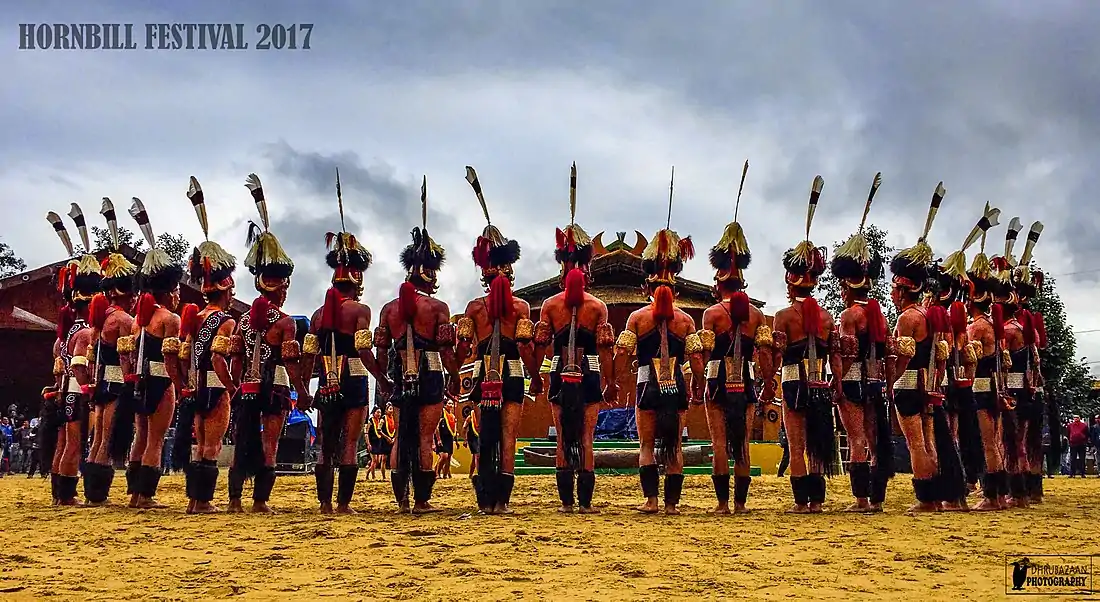Hornbill Festival
The Hornbill Festival is a celebration held every year from 1 to 10 December, in Nagaland, Northeast India.[1] It is also called the 'Festival of Festivals'.
| Hornbill Festival | |
|---|---|
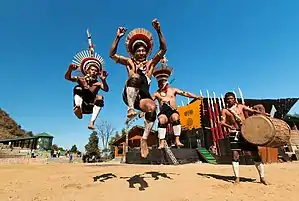 Nagas of Nagaland, India rehearsing their traditional dance during the Hornbill Festival | |
| Official name | Hornbill Festival |
| Observed by | Nagas |
| Type | Cultural Information |
| Significance | To revive, protect, sustain, and promote the richness of the Naga heritage and traditions |
| Date | 1 to 10 December |
| Frequency | Annual |
Background
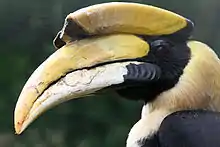
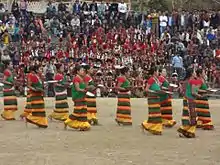
The state of Nagaland is home to several tribes, which have their own distinct festivals. More than 60% of the population of Nagaland depends on agriculture and therefore most of their festivals revolve around agriculture. The Nagas consider their festivals sacred, so participation in these festivals is essential.[2]
To encourage inter-tribal interaction and to promote cultural heritage of Nagaland, the Government of Nagaland organizes the Hornbill Festival every year in the first week of December. The first festival was held in 2000.[3]
The festival is named after the Indian hornbill, the large and colourful forest bird which is displayed in the folklore of most of the state's tribes.
Celebrations
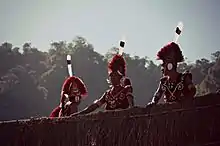
Organized by the State Tourism and Art & Culture Departments, the Hornbill Festival showcases a mélange of cultural displays under one roof. This festival usually takes place between 1 and 10 December every year in Kohima.[3]
The Hornbill Festival is held at Naga Heritage Village, Kisama which is about 12 km from Kohima. All the tribes of Nagaland take part in this festival. The aim of the festival is to revive and protect the rich culture of Nagaland and display its extravaganza and traditions.[1]
For visitors it means a closer understanding of the people and culture of Nagaland, and an opportunity to experience the food, songs, dances and customs of Nagaland.[4]
On 1 December 2017 at the Naga Heritage Village of Kisama, President Ram Nath Kovind inaugurated the 18th Hornbill Festival and State Formation Day celebrations of Nagaland.[5]
Festival activities
The week-long festival unites one and all in Nagaland and people enjoy the colourful performances, crafts, sports, food fairs, games and ceremonies. Traditional arts which include paintings, wood carvings, and sculptures are also on display.[6]
Festival highlights include the traditional Naga Morungs exhibition and the sale of arts and crafts, food stalls, herbal medicine stalls, flower shows and sales, cultural medley - songs and dances, fashion shows, the Miss Nagaland beauty contest, traditional archery, Naga wrestling, indigenous games, and musical concert.[1]
The Hornbill Festival provides a colourful mixture of dances, performances, crafts, parades, games, sports, food fairs and religious ceremonies. The festival both exposes the culture and tradition of tribal peoples, and reinforces Nagaland’s identity as a unique state in India’s federal union. Experts have commented that A lot of older folk in the villages travel to Kohima to attend this festival and meet people from other villages from Nagaland because they haven’t met before, hence leading to cultural assimilation.[7]
Traditional arts are also featured, with paintings, wood carvings, and sculptures by modern Naga artists on display. Naga troupes sing folk songs, perform traditional dances and play indigenous games and sports. In the evenings a programme of music concerts, catering for all tastes, ensures that the festive spirit continues through the night.[1] One of the major highlights of this festival is the Hornbill International Rock Festival, which is held at Indira Gandhi Stadium; local and international rock bands perform.[8]
Economic potential
The Hornbill Festival has contributed significantly to enhancing the state's tourism brand. Tourism promoters believe that the Hornbill Festival in Nagaland allows tourists to have an insight into the different tribes of Nagaland.[7] It fosters understanding of the rich cultural heritage of the state, its resourceful architecture and its ethnic cuisine.[9]
Festival Ground
Camping Facility
Camping facility available near the Hornbill Festival event area organised by local tour operator Camp Zingaros.[10]
 Camp site at Hornbill Festival at Kisama, Kohima, Nagaland by Camp Zongaros
Camp site at Hornbill Festival at Kisama, Kohima, Nagaland by Camp Zongaros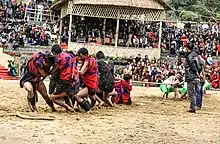 Hornbill Festival
Hornbill Festival A camp site at Hornbill Festival, Kisama, Kohima, Nagaland by Camp Zongaros
A camp site at Hornbill Festival, Kisama, Kohima, Nagaland by Camp Zongaros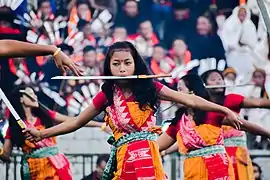 Bodo-Kachari Tribe-women at Hornbill Festival
Bodo-Kachari Tribe-women at Hornbill Festival
See also
References
- Jaini, Kshaunish (6 January 2017). "Nagaland – Hiking and Hornbill Festival in India". Alien Adventure. Archived from the original on 5 December 2017. Retrieved 5 December 2017.
- Hornbill Festival - Where the Action is... Archived 19 November 2011 at the Wayback Machine, EF News International. 16 November 2011.
- Hornbill Festival of Nagaland, India-north-east.com
- "Hornbill Festival 2016 - December". Festivals of India. New Delhi: Pan India Internet. Archived from the original on 3 February 2017.
- Srivastava, Priya (4 December 2017). "Hornbill Festival 2017 – 73,090 people visit in three days". Gurgaon, India: Happy Trips (Times Internet). Archived from the original on 5 December 2017.
- Nagaland's Hornbill Festival Goes International. Outlook India.com. 1 December 2009.
- "' A window to the northeast'". The Hindu. 1 November 2016. Retrieved 21 March 2017.
- "Hornbill Festival 2015 - Hornbill Rock Contest". www.hornbillfestival.com. Retrieved 12 December 2015.
- "'Ignore the potholes, enjoy the ride'". The Hindu. 22 January 2016. Retrieved 17 January 2017.
- "Discover Northeast: Camp Zingaros". Discover Northeast. Retrieved 26 October 2019.
External links
| Wikimedia Commons has media related to Hornbill Festival. |
- Hornbill Festival
- Official website
- YouTube clip
- Tourists to Nagaland require a permit to visit the state.[1]
- "Inner Line Permit | Ministry of Development of North Eastern Region, North East India". mdoner.gov.in. Retrieved 12 December 2015.
